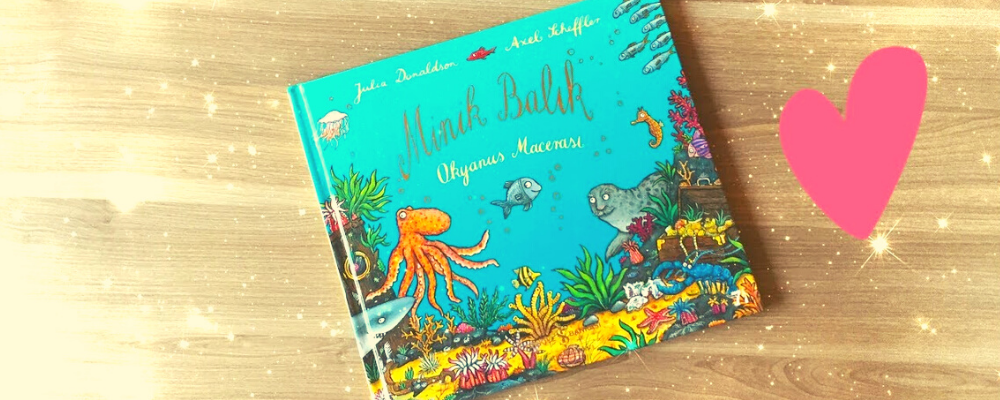Julia Donaldson tells the adventures of a fish who loves telling stories and has a great imagination in her book Tiddler the Story Telling Fish. From this aspect, it is mostly similar to many other books in the field of children’s books.
Julia Donaldson tells the adventures of a fish who loves telling stories and has a great imagination in her book Tiddler the Story Telling Fish. From this aspect, it is mostly similar to many other books in the field of children’s books. However, there is one thing which differs the book from others: the author organizes a children’s book by using the features of post-modern stories. This character of the text is only recognized on the last page of the book and brings a playful tone to the story. The reader realizes that the story he/she is reading or being read to him/her is the book that he/she is holding or the reader is holding. In this way, the child reader encounters with the postmodern reality. Even possibly, he/she encounters, for the first time, with a book which fits his/her reality, which is why I said he/she understands that the book that is being read is the book the reader is holding. Hence, the book becomes a concrete object in the eye of the child.
Ihab Hassan mentions the concept of “game” as a feature of post-modern stories in his article, where he schematizes the features of modern and post-modern stories with their differences.[1] This concept of the game is, in a way, connected to the rhetoric. In other words, the game is closely related to the mode of articulation of the story. In this regard, what is crucial in post-modern stories is the way the story is being told rather than the type of story. The game may be a wordplay as well as it may be a game on the book which is held by a reader or a concrete connection between the book the reader, as we see in the book Tiddler: the Storytelling Fish. In this case, what attracts the child reader to listen to this book would be the playful tone of the story. Tiddler is a fish who lives in the ocean and goes to school with his friends. However, he never arrives to school on time and every time he has to explain the reason for being late to his teacher with a different story. In fact, name of the book is Tiddler: the Storytelling Fish. In this naming, the author has chosen a feature which defines the little fish with his the most important character. On the other hand, it is an interesting detail that the word “Tiddler” resembles the word “Toddler”. In a way, the author implies the target audience by selecting the word Tiddler as the name of the main character and it is close to word toddler meaning, “a child learning to walk”. When it is considered from this perspective, a wordplay made by changing only a letter can be considered as one of the features of the post-modern story.
Tiddler, in his stories, “rides a seahorse”, “wanders with a thornback”, and “dives with a dolphin”. Furthermore, at once, while he was playing at a shipwreck, he gets locked up in a treasure chest and a mermaid saves him. The narrator tells the stories of the little fish with a playful tone. Tiddler always gets lost simultaneously, he does not appear in the story during attendance taking, but then, all of a sudden, he appears in the class with his story like saying “peekaboo”. Considering this book can be read to toddlers, the narration technique of the book gains a different importance because games which include hiding and finding an object gives the child a belief that the object does not disappear. According to the developmental psychology and game theory, the learning outcomes of the games at this age are important for both cognitive and linguistic development.
Only “Little John Dory” believes in Tiddler’s stories and he tells these stories to his “grandmother” and these stories become the guide for Tiddler who gets lost in the ocean. As follows, one “Wednesday morning when the clock is about to hit nine”, Tiddler thinks about the most interesting story that he can tell. He falls so much into a reverie that he can’t see the approaching fisherman. The fishermen’s fishing net catches him and takes him to the ship. However, since he is so little, they let him back in the ocean. There is a real adventure waiting for Tiddler in the ocean. He encounters with many different species he doesn’t know. At the moment when he was scared and hidden “behind the seaweed”, he hears “a familiar story”. Tiddler rides the sea horse going clip clop. Tiddler saw a mermaid. A turtle saved Tiddler from the arms of a cuttlefish. Tiddler found a giant sparkling treasure chest. No way, I don’t believe it. But it really happened.
Tiddler starts tracing his own stories. First, he encounters a group of anchovies. He asks them, “Excuse me, can you tell me where did you hear this story?” One of the anchovies says that he heard it from a shrimp. Tiddler goes to shrimp, shrimp leads him to a whale. From whale to a herring, from herring to an eel, from eel to a lobster, from lobster to a seal, from seal to a starfish, from starfish to a halibut. So, they all heard the story from one another. The halibut recognizes him and takes him to Little John Dory’s grandmother. While students were preparing to go back to home at “three thirty”, Tiddler comes to school and tells what happened. Once again, nobody but Little John Dory believes him.
At the end of the narration, stories of Tiddler with his “endless imagination” and “silver fins” become a real book because Little John Dory who fondly listens to his stories and believes in them, tells all Tiddler’s stories including the last one to one of his friends who is an author. The author writes the book namely, Tiddler: The Story Telling Fish book. Thus, it becomes a work of art which has the feature of the post-modern story.
Bibliography
Donaldson, Julia ve Axel Scheffler. Minik Balık: Okyanus Macerası. Çev. Nevin Avan Özdemir. İstanbul: Türkiye
İş Bankası Yayınları, 2015.
Hassan, Ihab. “Toward a Concept of Postmodernism”. The Postmodern Turn. Columbus: Ohio State University
Press, 1987.
[1] Ihab Hassan, “Toward a Concept of Postmodernism,” The Postmodern Turn 1987 :6.

